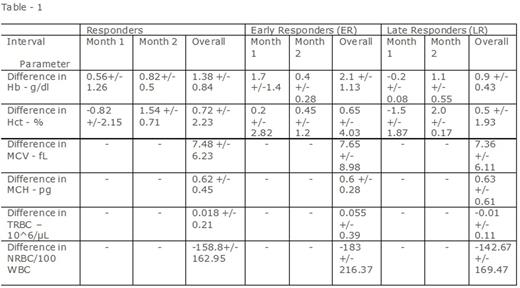Abstract
Introduction
HbE/Beta Thalassaemias are the commonest of the haemoglobinopathies in the East Zone of India. Due to extreme diversity of clinical presentation, they have been subjected to fetal haemoglobin inducers, empirically, seeking transfusion independence. Several genetic determinants have been identified but none conclusive, either individually or in combination, in prediction of response. In this study we tried to retrospectively analyze only haematological parameters as predictors of transfusion independence to Hydroxyurea therapy.
Study proper
Only 205 adults, suffering from Non Transfusion Dependent HbE/Beta Thalassaemia, [IVS-I, 5(G>C)/CD26 (G>A)] was selected. Of them 168 were declared negative by NAT for transfusion transmissible viruses and tuberculosis, were selected for this study, with consent and IEC approval.101 males, 67 females, all splenectomized, mean age 24 years, ranging from 18 to 45 years. 2.5 ml, pre-transfusion sample of peripheral blood was collected in K2EDTA and analyzed using XE100 Automated Haematology analyzer by Sysmex. This was done on monthly. Transfusion was initiated if the level of haemoglobin fell below 6.5 g/dl or the subject felt it was required. Hydroxyurea was started at a dose of 10 mg/kg /day at day zero. This was continued for 12 months and the results of Complete Haemogram and transfusion requirement were compared statistically.
Results & Discussion
Parameters of response were set as
1) Increase in level of haemoglobin > 1.0 gm/dl over pretreatment levels
2) Sense of wellbeing
3) Transfusion independence
Based on these criteria, the population was divided into 2 groups - Responders and Non-responders. Responder - 115 (68.45%), Non-responder - 53 (31.54%). Haemoglobin level increased by 2.53 +/-1.26 g/dl, range 1.09 - 3.7 g/dl, over the entire study period. In 69 (60%) cases there was reduction, 46 (40%) cases there was increase in total haemoglobin in the 1st month of study, but both the first and second groups recorded increase in total haemoglobin 2nd month onwards. So the responders were into Early and Late Responders (ER & LR), depending on initial increase or reduction of haemoglobin.
For results - Refer to Table - 1, 2
Total haemoglobin increased significantly at the end of study, though there was decrease in total haemoglobin in the first month, difference at end was not statistically significant. Reduction of Hct, TRBC and NRBC and increase in MCV and MCH were noted in all. Though there was difference in all the parameters in both ER and LR groups but no statistically significant difference was noted at the end of study. Increase in MCV and MCH and reduction in number of NRBCs were consistent with response.
The patients classified as non-responders, recorded haemoglobin levels below 6.5 gm/dl and had to be transfused every 1.2 to 2 months for sustenance, rendering the tested values ineligible for comparative study.
Conclusion:
NTDT patients exhibit reduction in NRBC and increase in MCV and MCH within the first 2 months on Hydroxyurea, would respond to therapy. If there is no reduction of NRBC and increase in MCV and MCH after 2 months, treatment with fetal haemoglobin inducers should be withdrawn.
No relevant conflicts of interest to declare.
Author notes
Asterisk with author names denotes non-ASH members.



This feature is available to Subscribers Only
Sign In or Create an Account Close Modal